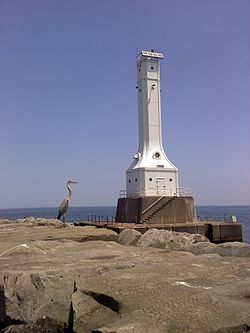 Huron Harbor Light | |
 | |
| Location | Huron, Ohio, United States |
|---|---|
| Coordinates | 41°24′16.59″N82°32′37.65″W / 41.4046083°N 82.5437917°W |
| Tower | |
| Constructed | 1939 [1] |
| Foundation | cement |
| Height | 22 m (72 ft) |
| Shape | Square |
| Heritage | National Register of Historic Places listed place |
| Light | |
| First lit | 1936 |
| Focal height | 24 m (79 ft) |
| Range | 10 nmi (19 km; 12 mi) |
| Characteristic | Iso W 6s |
The Huron Harbor Light is a lighthouse in Huron, Ohio on Lake Erie, on the west pier of the Huron Harbor.
